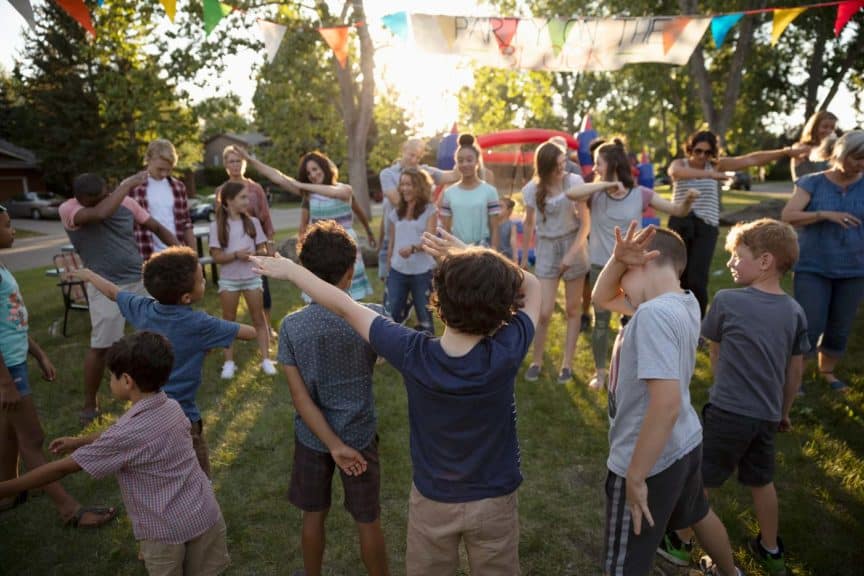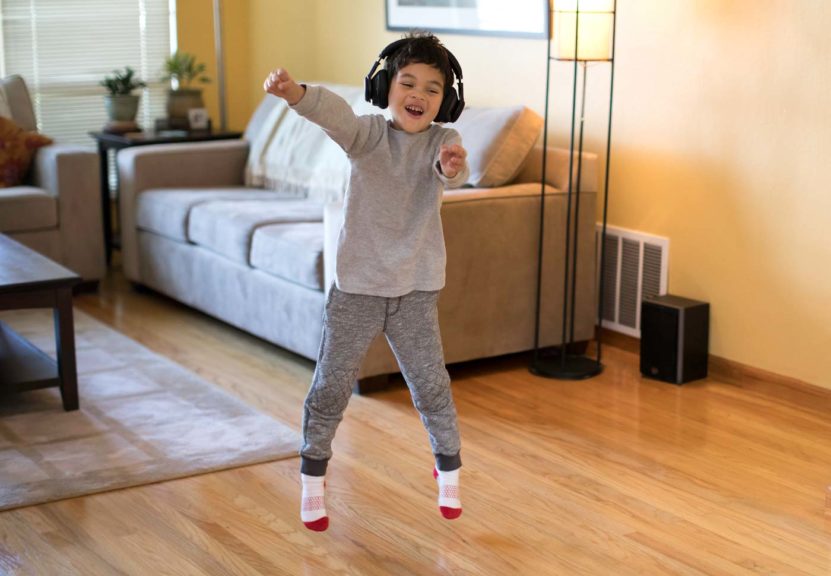One of the most common areas that people struggle with in kids’ worship is getting the boys engaged.
Boys can and will participate in worship. I have seen it firsthand more times than I can count. And every time I do, I take a mental photo so I can remember that boys can and will sing.
If you aren’t seeing boys participate in worship, there are several things for you to think about as you evaluate what you currently do for kids worship. Read this post on 5 Surprising Solutions article to help you navigate potential next steps.
I believe the five things I outline in that post play a huge part in this topic of boys and worship. But there are a couple other areas I want to invite you to consider.
Do Your Volunteers Model Worship for Everyone?
Get your full volunteer team on board and active in the role of engaging kids—including the boys—in worship.
Do Male Leaders Worship Alongside the Boys?
Last summer I was leading worship at a preteen camp in Texas. I’ll never forget one morning in chapel. There were several rows of boys front and center who were engaged, participating, and all in to worship.
I was so happy to notice a counselor filming them because it was one of the many moments I wish my human eye could film the things I get to see as I lead from the stage. (You can see the video on my Facebook page.) Isn’t it incredible to see those boys giving it their all?
As I talked with the Kidmin Director of this group of boys, she confidently championed the role her volunteers have in modeling worship to everyone. The male volunteers who help in the class and lead small groups don’t stand in the back or on the sidelines. They take part and go all in, cheering the boys on through their example.

I asked her what she does to get her adult volunteers to be so involved in participating along with the kids. Here’s what she said.
“For starters, at our church, it starts from the top. Our men are modeled worship from the worship team every Sunday.
Secondly, I cast vision about worship for the kids and the leaders. The leaders know that I expect them to worship alongside the boys during our ministry times.
And thirdly, I think seeing fruit from it—the boys starting to learn what worship is all about—is what helps keep it going. Having committed male adult leaders worship alongside our boys has drastically changed the way worship happens in our kids’ spaces.
They model what worship looks like for the boys to see. It’s not always perfect, and we definitely sometimes have some flossing during worship time. But having male leaders worship alongside the boys shows them that worship is not just for females, and that it’s cool.”
I wholeheartedly agree that engaging kids in worship starts with vision. Model worship from the stage (in all classrooms in your church) and in the kids’ classroom. Help volunteers understand that nobody sits on the sidelines.
Every leader is there to help encourage and show kids how they can participate in worship.
Do Your Volunteers Know Worship Is Contagious?
Behavior is contagious in an audience. The bigger the crowd, the easier behavior spreads, because everybody feeds off each other. All you need is a spark to start a fire, and your adult leaders can help spark engagement during worship.
It’s so important for you to get this into your volunteers. They need to understand that they’ve got to participate. They can’t just stand there or sit there while you’re expecting the kids to be engaged.

Worship is not a “do as I say, not as I do” situation. Whether volunteers are in the aisles, the back of the room, the sides, or in the mix with the kids, they’ve got to join in and model the behavior we are leading kids toward.
Do Your Volunteers Own Their Influence?
I led worship for a preteen event called SuperStart. Throughout the different sessions, the groups rotate around the room. Every now and then during one of the sessions, I would end up with a group in the first couple rows who would sit there during a song—even though I had asked the whole room to stand. (They probably stayed up too late or were coming down from a sugar high, but still!)
I couldn’t believe how many times I saw an adult leader follow what the kids were doing and stay seated. As a leader, their role was to encourage the kids by standing and saying, “You’re going to stand right now. This is what we’re going to do.”
Help your team realize the power they have to disciple young Christ followers through the discipline of worship. Remind them that they need to lead and model well because young eyes are watching their every move. Champion your volunteers with the knowledge that they have power and influence to help lead worship from within the audience.
Do You Have a Compelling Purpose for Worship?
Many of you struggle with boys who have completely disengaged from worship. They may have unplugged because of a hardened heart, a negative attitude, a lack of understanding, or by following the lead of a friend.
I want to unpack a few things that I have wrestled with and processed about this. Thinking through what you are inviting kids to do in worship is incredibly important.
Are You Relying Too Much on Motions?
I’ll be completely honest with you. A lot of leaders in children’s ministry have bought into a false sense of worship engagement. They expect there to be motions from start to finish of every song.
When the whole room is bouncing a certain way or moving side to side on the count of three, it makes us feel good that there was a lot of energy and movement in the room. And that may have happened, but it doesn’t mean worship happened that day.
Do movements have a purpose? Yes, absolutely. But somewhere along the way we started equating kids’ worship with movement from beginning to end of EVERY song.

In the process we lost a lot of meaning and purpose. It’s like the difference between a diet of all dessert versus a balanced diet of protein, fruits, and vegetables. We know that eating only sugar is a highway straight to decay. It might taste good going down, but it’s not nourishing a strong and flourishing body.
The same is true for our kids’ worship. Is there a time and a place for the whole room to bounce and move? Yes, of course. But, that’s in addition to, not instead of, learning what worship is all about.
Is Your Worship Preparing Kids for Life’s Battles?
Worship is focusing the heart and mind, lifting our hands in surrender to say, ‘I’m all Yours, Father God. Pick me up. I need You.”
Life is full of battles. All kids today, including boys, are dealing with some crazy stuff. They need to experience the hiding place of God’s presence. They need this now, they’ll need it next year, and they’ll need it for decades to come.
Children are the easiest group to lead in worship. Discipling them now in the area of worship is setting them up for a lifetime prepared to navigate whatever battle they may encounter.
Through the worship songs they get to sing, boys learn a vocabulary and a heart posture to honor the Lord and trust Him through anything and everything.
Do Boys See There Are Many Ways to Worship?
Songs that are packed non-stop with motions are a good way to alienate the oldest kids—and the boys—in your class.
What are you inviting boys to do in worship? If all they see is a dance routine, lot of boys are going to say “no thanks” and tune you out.
Most children’s worship has a one-size-fits-all participation model that just doesn’t work.
Years ago, I had a song with motions. I could teach those motions to a group of preteens, and they would do them no questions asked.
Then I could do the exact same song and movements in a room that included preteens and younger kids. When it was a broad range of ages, the oldest kids in the class would suddenly not participate. I did the exact same thing but got different results.
This experience took me on a journey of reevaluating what I did, how I did it, and what I wanted to invite my audience to do. I repeated my experience in different states and cities. Again, I wondered why once the youngest kids were in the room these oldest kids wouldn’t do it?
What I saw convicted me. I felt weighted with a responsibility to ask, “What is making them uncomfortable and not want to do it?” This led me to the realization that having a broader number of ways for kids to engage throughout worship time is much more realistic.
Does All Your Worship Look the Same?
Some of your kids love motions. They want to do them all the time and that’s cool. But some of your kids (especially the boys) don’t. And if you’re showing that motions are the only way they can participate in worship, you’re pushing them away rather than drawing them in. That’s why you don’t have engagement from certain kids.

Pushing them away is unacceptable to me. I also believe the way we worship should prepare kids for the age group they will enter next.
What if your church’s middle schoolers don’t use worship motions? Set your kids up to win when they graduate your children’s ministry by showing them there are other ways to participate in worship.
On certain songs (or even parts of songs) start giving them a model and experience that is just standing and clapping or lifting their hands.
Every song doesn’t have to look the same way.
I noticed in watching Hillsong Kids DVDs and even at Camp Kidjam that everyone on stage isn’t doing the same thing. Worship leaders are just singing and leading. Dancers are doing motions.
Sometimes it’s a mix of those things, but modeling from the stage at least a couple different ways to participate opens the door to include more kids. When I do that, I have just made it possible to have a higher percentage of my audience engage in what we are doing. I’ve made space for different personalities to participate in worship.
Are You Strategic in the Motions You Do Use?
I have found that generic, simple, and selective movements help me engage a lot more kids. It also helps me win some cool points with those kids that don’t love doing the motions (like many boys).
Being selective and even strategic in the movements I choose also means that when I do invite kids to do a movement, they will engage. That’s because I haven’t been asking for motions non-stop in every worship song we do.
So in the clip from camp we were doing my song “Super Wonderful (Comic)” I have motions only on the chorus, and they are crazy simple. “Super big (arms up), super strong (muscle arms), super wonderful (wave arms left, right, left, right), God (point up).”
It wasn’t anything you had to study for months. There wasn’t spinning and a twirl and boot scoot boogie to the side. It’s very simple and generic, and, most importantly, it was selective. We’re not going to do it from start to finish of the whole song. We’re only going to do the motions on the part that makes most sense.
Asking yourself, “What is the most obvious thing you can do when you hear those words or that part in the song?” is a great place to start. Your motions should be obvious to increase engagement.
Are You Choosing Motions Boys Will Be OK With?
I’m always going to be about a clapping section, a jumping section, a fist bump section, and arms waving back and forth. None of those are super offensive to a boy.
They are simple things everybody can do and not look silly doing. They also don’t require you to study for six weeks or take a dance class to learn.
Putting It All Together
Ask yourself hard questions and evaluate what you are inviting boys to do in worship. Inspire the boys AND the girls with examples and leaders who are modeling for them how to engage and what a heart of worship looks like. (I have crafted five lessons to help you teach this to your kids through a series called Heartbeat.)
I hope you hear all of me say this in love and kindness. I am cheering you on and want more than anything for worship to be a WIN in your children’s ministry.

Discover the Enneagram’s Surprisingly Simple Approach to Engaging Volunteers

Discover the Enneagram’s Surprisingly Simple Approach to Engaging Volunteers









